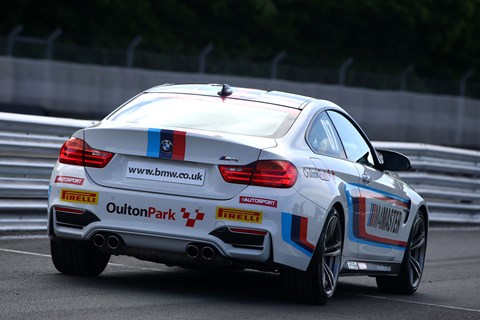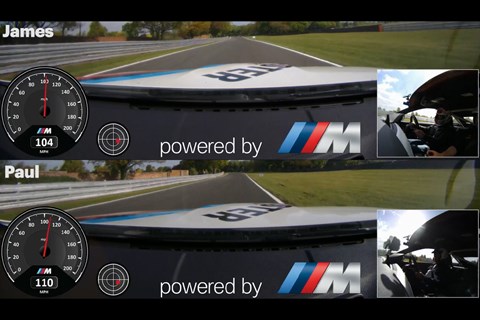► One of our own takes on a pro
► How much quicker is a real racing driver?
► At Oulton Park in a BMW M4
Just how much quicker is a professional racing driver than us mere mortals? Sure, they’ve had years of practice and possess superhuman levels of car control, but in a straight fight, in the same car and on the same circuit, how much of an advantage do they really have?
To find out, we sent one of our hand-picked humans along to Oulton Park for a customer performance driving experience with BMW. And, to make sure we could see exactly where the pro racer was making up time, we’d have access to on-board footage and in-car telemetry.
Using this we can see the drivers’ steering angles, braking points and speed, picking out what separates the racing driver from the journalist.

The racing driver in question would be ex-BTCC race winner (and resident Oulton Park instructor) Paul O’Neil, while the chosen track-ready weapon would be a BMW M4 on upgraded tyres, brakes and a roll cage installed. The, tame journalist meanwhile, would be me, James Dennison.
Like many petrolheads, I’ve done plenty of karting and spent a decent amount of time pounding around various tracks across the country. But never at Oulton Park and never in a BMW M4. Hopefully this won’t be a bloodbath…
The top part of the telemetry graph plots our speeds, while the bottom shows the cumulative lap time difference between us. Paul (the professional racing driver) is the red line in red, while I’m the blue line. The video brings the two drivers level after each sector, in order to aid comparisons.
Sector 1

Our lap begins on the start/finish straight at Oulton Park, with Paul and me heading into the first corner at over 100mph.
Encouragingly (for me), we both hit the brakes at the same time on entry into the corner. Paul, however, makes a fractionally later turn-in and as a result gets a better exit from the bend. I on the other hand, lose about 5mph as the M Dynamic Mode (MDM) assistance cuts in and reduces power – likely detecting that there was a chance of an impressive (but expensive) crash.
BMW stipulated that the MDM assistance must be kept on throughout my time on track, and while it’s a fairly lenient system, it still cut in too often for my liking.
Sector 1 ends with James losing 0.91 seconds to Paul.
Sector 2

Here’s a surprise; as the second sector starts I’m actually gaining time on Paul, carrying noticeably more speed into Cascades! My joy is short lived though, as Paul gets on the brakes earlier for the left hander, then chucks the car into the tight right at the bottom of the hill. I really should have been more ambitious going into the latter, Paul’s entry speed a whole 12mph faster than mine.
Things look up though, as, despite short-shifting and struggling for traction out of the corner, I’m able to virtually match Paul all the way up Clay Hill towards the black Pirelli bridge.
Sector 2 ends with James losing a further 0.78 seconds to Paul.
Sector 3

Coming up to Druids corner, Paul uses more of the track and is able to carry greater speed into this tricky-double apex bend. Whereas he’s hugging the left of the track under hard braking, I’m out in no man’s land in the middle of the circuit, spoiling my entry into the corner. As a result, Paul flies past the first apex, carries more speed (around 5-7mph) past the second apex and gets a better exit onto the straight.
The speed which I lost on the way into and through Druids now costs me dearly all the way down to Lodge Corner.
Briefly winding back to the end of sector 2, my downfall in sector 3 can largely be traced to not hugging the white line (shown below) on my way up to the left hander before Druids.

Had I have done this, I could have theoretically braked straighter and got a better line through the double apex. It sounds like such a simple piece of advice, but using all of the track really does make the world of difference.
Sector 3 ends with James losing a further 0.94 seconds to Paul
Sector 4

Beginning around the braking point for Lodge Corner, sector 4 shows us both hitting the anchors at almost exactly the same time. Interestingly, Paul slows the car down to the point where our corner entry speeds are identical, yet manages to get a burst of extra speed on the way out. How? He gets on the power a fraction earlier, and, although he has to correct a flick of oversteer on the way out of the bend he carves out a small advantage.
All that’s left now is a slight left hander under the bridge and a run to the finish line. Paul grabs another piece of time off with a better-timed gearchange (and fractionally improved line) as we reach the top of the hill.
Sector 4 ends with James losing a further 0.72 seconds to Paul
Paul’s best time: 1:11:71
James’s best time: 1:15:08
In the battle of racing driver vs. human, the former managed to pull out an advantage of 3.37 seconds. Not the annihilation I feared, but still noticeable. After going through the telemetry and seeing where I lost time (especially through Druids), I reckon that with a few more hours on track I could get to around 1 minute 13 seconds dead. Why not any faster?
That’s where years of racing experience (and talent) come in. Shaving off those extra few tenths would be a task which I could no doubt waste many years, relationships and eye-watering amounts of money on.
What’s the gap between a human and a racing driver, then? About three seconds as it turns out.
Check out our review of the BMW M4 CS – the Goldilocks of the range?